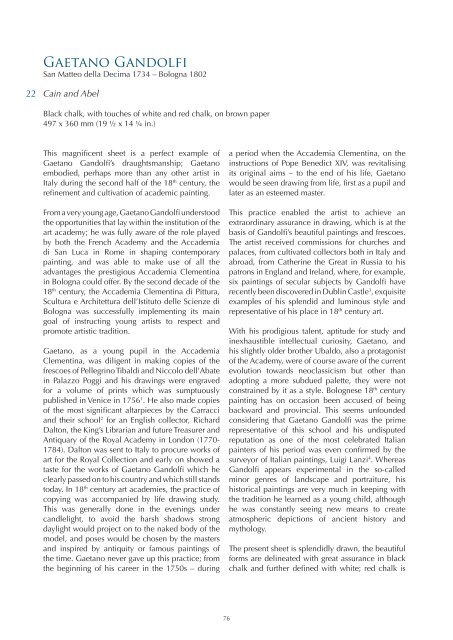XV - Works On Paper - Marty de Cambiaire (English)
Create successful ePaper yourself
Turn your PDF publications into a flip-book with our unique Google optimized e-Paper software.
Gaetano Gandolfi<br />
San Matteo <strong>de</strong>lla Decima 1734 – Bologna 1802<br />
22<br />
Cain and Abel<br />
Black chalk, with touches of white and red chalk, on brown paper<br />
497 x 360 mm (19 ½ x 14 ¼ in.)<br />
This magnificent sheet is a perfect example of<br />
Gaetano Gandolfi’s draughtsmanship; Gaetano<br />
embodied, perhaps more than any other artist in<br />
Italy during the second half of the 18 th century, the<br />
refinement and cultivation of aca<strong>de</strong>mic painting.<br />
From a very young age, Gaetano Gandolfi un<strong>de</strong>rstood<br />
the opportunities that lay within the institution of the<br />
art aca<strong>de</strong>my; he was fully aware of the role played<br />
by both the French Aca<strong>de</strong>my and the Acca<strong>de</strong>mia<br />
di San Luca in Rome in shaping contemporary<br />
painting, and was able to make use of all the<br />
advantages the prestigious Acca<strong>de</strong>mia Clementina<br />
in Bologna could offer. By the second <strong>de</strong>ca<strong>de</strong> of the<br />
18 th century, the Acca<strong>de</strong>mia Clementina di Pittura,<br />
Scultura e Architettura <strong>de</strong>ll’Istituto <strong>de</strong>lle Scienze di<br />
Bologna was successfully implementing its main<br />
goal of instructing young artists to respect and<br />
promote artistic tradition.<br />
Gaetano, as a young pupil in the Acca<strong>de</strong>mia<br />
Clementina, was diligent in making copies of the<br />
frescoes of Pellegrino Tibaldi and Niccolo <strong>de</strong>ll’Abate<br />
in Palazzo Poggi and his drawings were engraved<br />
for a volume of prints which was sumptuously<br />
published in Venice in 1756 1 . He also ma<strong>de</strong> copies<br />
of the most significant altarpieces by the Carracci<br />
and their school 2 for an <strong>English</strong> collector, Richard<br />
Dalton, the King’s Librarian and future Treasurer and<br />
Antiquary of the Royal Aca<strong>de</strong>my in London (1770-<br />
1784). Dalton was sent to Italy to procure works of<br />
art for the Royal Collection and early on showed a<br />
taste for the works of Gaetano Gandolfi which he<br />
clearly passed on to his country and which still stands<br />
today. In 18 th century art aca<strong>de</strong>mies, the practice of<br />
copying was accompanied by life drawing study.<br />
This was generally done in the evenings un<strong>de</strong>r<br />
candlelight, to avoid the harsh shadows strong<br />
daylight would project on to the naked body of the<br />
mo<strong>de</strong>l, and poses would be chosen by the masters<br />
and inspired by antiquity or famous paintings of<br />
the time. Gaetano never gave up this practice; from<br />
the beginning of his career in the 1750s – during<br />
a period when the Acca<strong>de</strong>mia Clementina, on the<br />
instructions of Pope Benedict XIV, was revitalising<br />
its original aims – to the end of his life, Gaetano<br />
would be seen drawing from life, first as a pupil and<br />
later as an esteemed master.<br />
This practice enabled the artist to achieve an<br />
extraordinary assurance in drawing, which is at the<br />
basis of Gandolfi’s beautiful paintings and frescoes.<br />
The artist received commissions for churches and<br />
palaces, from cultivated collectors both in Italy and<br />
abroad, from Catherine the Great in Russia to his<br />
patrons in England and Ireland, where, for example,<br />
six paintings of secular subjects by Gandolfi have<br />
recently been discovered in Dublin Castle 3 , exquisite<br />
examples of his splendid and luminous style and<br />
representative of his place in 18 th century art.<br />
With his prodigious talent, aptitu<strong>de</strong> for study and<br />
inexhaustible intellectual curiosity, Gaetano, and<br />
his slightly ol<strong>de</strong>r brother Ubaldo, also a protagonist<br />
of the Aca<strong>de</strong>my, were of course aware of the current<br />
evolution towards neoclassicism but other than<br />
adopting a more subdued palette, they were not<br />
constrained by it as a style. Bolognese 18 th century<br />
painting has on occasion been accused of being<br />
backward and provincial. This seems unfoun<strong>de</strong>d<br />
consi<strong>de</strong>ring that Gaetano Gandolfi was the prime<br />
representative of this school and his undisputed<br />
reputation as one of the most celebrated Italian<br />
painters of his period was even confirmed by the<br />
surveyor of Italian paintings, Luigi Lanzi 4 . Whereas<br />
Gandolfi appears experimental in the so-called<br />
minor genres of landscape and portraiture, his<br />
historical paintings are very much in keeping with<br />
the tradition he learned as a young child, although<br />
he was constantly seeing new means to create<br />
atmospheric <strong>de</strong>pictions of ancient history and<br />
mythology.<br />
The present sheet is splendidly drawn, the beautiful<br />
forms are <strong>de</strong>lineated with great assurance in black<br />
chalk and further <strong>de</strong>fined with white; red chalk is<br />
76
















